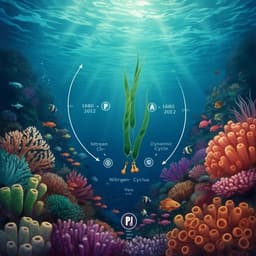
Earth Sciences
Fraser Island (K'gari) and initiation of the Great Barrier Reef linked by Middle Pleistocene sea-level change
D. Ellerton, T. M. Rittenour, et al.
Discover the intriguing timeline of Fraser Island and the Great Barrier Reef! This research by D. Ellerton, T. M. Rittenour, and their team reveals how the formation of Fraser Island's dunes during the Middle Pleistocene linked to significant coral reef development.
~3 min • Beginner • English
Introduction
The study addresses why and when Fraser Island (K’gari) and the modern Great Barrier Reef (GBR) formed despite long-term tectonic stability and suitable climatic conditions since at least the Pliocene along eastern Australia. Although proto-reef phases date to the Miocene, in situ coral evidence places formation of the extant GBR in the Middle Pleistocene (~450–670 ka). The authors hypothesize that coastal sediment dynamics linked to sea-level variability during the Middle Pleistocene Transition (MPT) controlled the timing of Fraser Island dune-field development and consequently GBR initiation. They present new chronologies for the Cooloola Sand Mass and Fraser Island to test whether heightened sea-level amplitudes during the MPT reworked mid-shelf sands shoreward, built large dune barriers, and reduced siliciclastic supply north of Fraser Island, enabling widespread coral reef establishment.
Literature Review
Prior work indicates early to middle Miocene (~23–12 Ma) reef phases along NE Australia, but modern GBR initiation is much younger, with estimates of ~450 ka based on in situ corals and distal offshore records suggesting MIS 15 (~621–563 ka). Eastern Australia has experienced long-term tectonic quiescence since ~25 Ma with the Antarctic Circumpolar Current onset, and climatic conditions suitable for reefs since the Pliocene, making the young GBR a puzzle. Existing chronologies from Cooloola indicate sand accumulation since at least ~730 ka, with hypotheses linking coastal dune formation to rising sea levels and reworking of shelf-stored sediment. Additional studies document longshore sand transport enhancement at −60 m shorelines during glacial lowstands and subsequent shoreward reworking during transgressions. Competing hypotheses for GBR initiation include: northward plate motion and sea-surface warming; an unusually warm MIS 11 interglacial; and shelf widening/deepening associated with longer, higher-amplitude highstands across the MPT. Distal records (e.g., ODP Site 1195) show carbonate content increases and terrigenous decreases near ~700 ka, interpreted as GBR initiation and inshore siliciclastic trapping. The present study proposes an alternative/complimentary mechanism: formation of Fraser Island during the MPT reduced northward siliciclastic flux, permitting carbonate dominance and reef initiation.
Methodology
- Study area and stratigraphic logging: Three detailed sections along Rainbow Beach cliffs (Cooloola Sand Mass) and an additional Fraser Island cliff section were logged for sedimentology and pedology (grain size, sorting, roundness, bedding, mineralogy, Munsell color, textures). Pedostratigraphy (E, B, C horizons) defined allostratigraphic dune packages bounded by discontinuities. Drone imaging (DJI Mavic Pro, 12 MP) produced a 2D orthophoto mosaic across ~9 km; 211 photos processed in Agisoft Photoscan, interpreted in ArcGIS Pro and Illustrator to map units and correlate laterally.
- OSL sampling and analysis: Quartz sand (180–250 μm) collected from major stratigraphic units using 20 cm steel tubes; surrounding sediments sampled for dose rate and moisture. Processing under dim amber light with HCl, peroxide, heavy liquids, and multiple HF etches to isolate quartz; IR checks for feldspar contamination; aliquot rejection criteria applied (recycling ratio, recuperation, natural De). Single-aliquot regenerative-dose (SAR) protocol on small aliquots (~10 grains, 1 mm disks) using Risø TL/OSL DA-20 readers (470±30 nm LEDs), measured at 125 °C, 40–60 s stimulations through U-340 filters. Preheat plateau and dose-recovery tests indicated 200 °C/10 s preheat. Dose-response fits linear for <1 Gy; beyond linear, saturating exponential or exponential+linear fits. Equivalent dose (De) by Central Age Model (CAM); uncertainties at 2σ for De, ages at 1σ; errors in quadrature (instrument, dose rate, De). Dose rates determined via ICP-MS/AES for K, Rb, Th, U (bulk sediment); internal dose from purified quartz (Extended Data Table 1). Moisture content assumed 7±2% where in situ <7% due to outcrop drying. Cosmic dose calculated per Prescott & Hutton using burial depth, elevation, and coordinates.
- Palaeomagnetic sampling and analysis: Ferricrete samples (B or E horizons) targeted as reliable remanence carriers (goethite/hematite nanoparticles). Expected rapid post-depositional iron mobilization (10–20 kyr) provides near-primary ages relative to dune deposition. Oriented blocks collected; AF demagnetization up to 140 mT on 2-G magnetometer; due to high coercivity minerals, progressive thermal demagnetization emphasized, with precise low-temperature steps (80–120 °C) at the Geological Survey of Japan and higher temperatures (to 700 °C) at ANU. Characteristic remanent magnetization (ChRM) directions via principal component analysis with uncertainty propagation. Site means compiled; polarities assigned (normal/reversed/transitional).
- Data integration: OSL ages (Table 1), dose rate data (Table 2), internal dose rates (Extended Data Table 1), De distributions (Extended Data Fig. 7), luminescence curves (Extended Data Fig. 6), and palaeomagnetic results (Extended Data Fig. 8, Table 2 referenced) were integrated with stratigraphy (Fig. 2, Extended Data Figs. 2–5) to build a chronology and correlate with global sea-level/MIS records (Fig. 3).
Key Findings
- Timing of dune-field formation: The Cooloola Sand Mass and Fraser Island dunes formed predominantly between ~1.2 Ma and 0.7 Ma, within the Middle Pleistocene Transition (MPT, 1.4–0.4 Ma). Basal dune packages yield OSL ages ~0.8–1.2 Ma and exhibit reversed or transitional palaeomagnetic polarity, constraining them to older than the Matuyama–Brunhes boundary at 773 ka.
- Multiple dune packages: At Rainbow Beach, lower units are thick (10–30 m), tabular cross-bedded sets traceable for up to 8 km, indicating large-scale transgressive dune-field activation under high sediment supply during the MPT. Upper units comprise thinner, laterally variable parabolic dune packages associated with Late Pleistocene/Holocene reworking.
- Representative OSL ages (1σ): Dune package 1 includes 1,260±140 ka (RB5), 1,130±140 ka (RB10), 880±90 ka (RB12), 750±80 ka (RB7). Dune package 2 includes 860±100 ka (RB6), 720±80 ka (RB13), 710±80 ka (RB9), 670±70 ka (RB11), 570±70 ka (RB2), 500±50 ka (RB1). Dune package 3 includes 530±50 ka (RB16), 470±50 ka (RB14), 430±50 ka (RB15). Younger packages include 160±20 ka, 150±10 ka, 100±10 ka; the youngest dunes ~53±7 ka (RB20, RB21). Fraser Island cliff samples yield 790±90 ka (SRG2), 780±80 ka (SRG4), 770±80 ka (SRG3), 650±60 ka (SRG1).
- Palaeomagnetism corroboration: Reversed or transitional polarities in basal aeolian units (dune package 1 and base of package 2) and normal polarity in overlying packages confirm pre-773 ka deposition for lower units and Brunhes-age deposition for younger units.
- Mechanism: Increased glacial-cycle amplitude across the MPT (sea-level lows to −120 m from MIS 22 onward) exposed and reworked mid- to outer-shelf sands shoreward, dramatically increasing coastal sediment supply that fueled large transgressive dune formation (Cooloola, Fraser Island, and likely other SE Queensland sand islands).
- Coastal sediment system reorganization: Once established, Fraser Island acted as a groyne at the northern end of the sand island chain, diverting longshore-transported quartz sands off the continental shelf at Breaksea Spit toward the shelf edge and abyssal plain, thereby reducing siliciclastic input north of Fraser Island.
- Implications for GBR initiation: Reduced siliciclastic flux north of Fraser Island provided a necessary precondition for widespread coral reef development in the southern and central GBR during the MPT. Distal sediment records (ODP 1195) show a marked carbonate increase and terrigenous decrease around ~700 ka, consistent with this transition.
- Longshore transport context: Detrital zircon provenance indicates sources in NSW orogens and Hawkesbury Sandstone; ~1,500 km northward transport along the coast with net sand flux of ~500,000 m³/yr, depositing off the shelf north of Breaksea Spit.
Discussion
The findings link MPT sea-level amplitude increases to a step change in coastal sediment dynamics along eastern Australia. Exposure of mid-shelf sediment during deeper glacial lowstands and enhanced shoreward reworking during transgressions delivered exceptional sand volumes to the coast, enabling construction of large transgressive dune fields (Cooloola, Fraser Island). The resulting geomorphic barrier altered longshore sediment pathways: Fraser Island redirected quartz-rich sands off the shelf, decreasing turbidity and siliciclastic sedimentation on the inner shelf to the north. This sediment-starved setting was conducive to carbonate accumulation and coral reef establishment, providing a necessary precondition for GBR initiation during the Middle Pleistocene. The stratigraphic, OSL, and palaeomagnetic evidence coherently date dune emplacement to pre- and post-Matuyama–Brunhes times, aligning dune activation intervals with periods of large sea-level variability. The conceptual model suggests that the reorganization of sediment routing, rather than solely changes in temperature or a single interglacial, is central to explaining GBR timing. This mechanism likely has broader applicability to other passive-margin coastlines with extensive longshore drift and shelf-stored siliciclastics.
Conclusion
This study establishes a robust Middle Pleistocene chronology for the Cooloola Sand Mass and Fraser Island dune systems, demonstrating major dune-building episodes between ~1.2 Ma and 0.7 Ma driven by increased sea-level amplitudes across the MPT. The emplacement of Fraser Island reconfigured longshore sediment transport, diverting quartz sand off the continental shelf and reducing siliciclastic supply to the shelf north of the island. This created favorable conditions for carbonate sedimentation and widespread coral reef growth, providing a necessary precondition for the initiation of the southern and central Great Barrier Reef. The work highlights a major, climatically forced reorganization of a passive-margin coastal sedimentary system and suggests similar processes should be investigated on other passive margins (e.g., South Africa’s Wilderness Embayment, eastern Brazil). Future research should obtain higher-resolution chronological and sedimentological records along the GBR, expand shelf seismic and core datasets to track the timing of siliciclastic-to-carbonate transitions, and assess the generality of this mechanism globally.
Limitations
- Chronological constraints: Oldest OSL ages approach signal saturation in at least one sample (USU-2259 with De slightly >2×D0), potentially leading to slight age underestimation; age scatter exists for basal units though uncertainties are moderate (~10–12%).
- Sampling access: Steep, unstable cliff sections limited full vertical logging at some sites; interpretations partly rely on lateral correlation using orthophotos.
- Moisture/dose-rate assumptions: A uniform moisture content of 7±2% was assumed where in situ values were <7% due to drying, introducing potential dose-rate uncertainty. Internal dose rates were measured only on select samples and generalized to others.
- Palaeomagnetism: Reliance on ferricrete horizons as remanence carriers introduces assumptions about timing of iron mobilization (estimated 10–20 kyr after deposition). Some sites yielded ambiguous or noisy polarity results; sample orientation uncertainty ±5°.
- Regional extrapolation: The link between Fraser Island formation and GBR initiation, while consistent with distal sediment records and sediment routing logic, would benefit from additional direct coral/reef-core chronologies and shelf sediment routing datasets to fully resolve spatial and temporal causality along the entire GBR.
Related Publications
Explore these studies to deepen your understanding of the subject.







